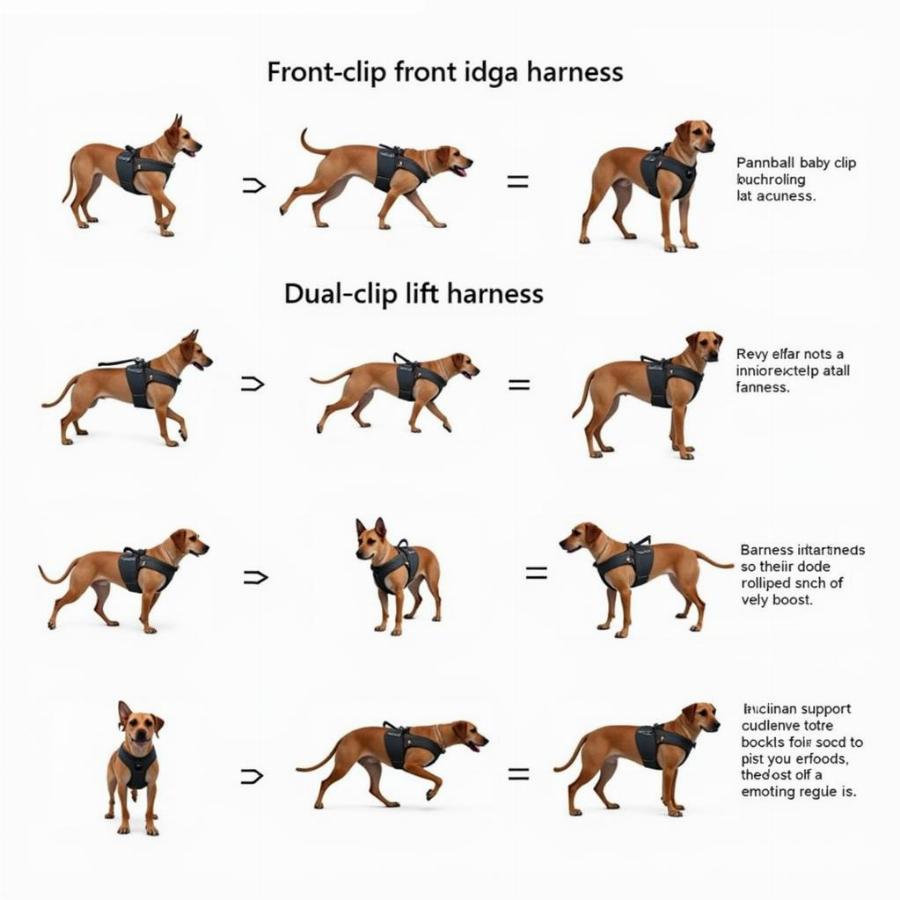Harness support for dogs offers a comfortable and safe alternative to traditional collars, especially for dogs with certain medical conditions, mobility issues, or behavioral challenges. Whether your furry friend needs a little extra help getting around or you’re simply looking for a more supportive walking experience, understanding the different types of harnesses and how to choose the right one is essential. Harness support isn’t just about physical support; it can also provide emotional comfort and improve training outcomes.
Understanding the Benefits of Harness Support for Dogs
Why choose a harness over a collar? While collars are common, they can put pressure on a dog’s delicate trachea, potentially leading to breathing problems or even injury, especially during pulling or sudden movements. Harness support distributes pressure more evenly across the chest and back, reducing strain on the neck and providing greater control and comfort. This is particularly important for brachycephalic breeds (like Bulldogs and Pugs) who are prone to respiratory issues. Moreover, harnesses can be a valuable tool for training, discouraging pulling and making walks more enjoyable for both you and your canine companion.
Choosing the Right Harness Support for Your Dog
With a plethora of harness support options available, selecting the right one can feel overwhelming. Consider your dog’s size, breed, age, and activity level. For puppies or small dogs, a lightweight and adjustable harness is ideal. Larger or more active breeds might benefit from a more robust harness with extra padding and secure fastenings.
Types of Harnesses and Their Support Functions
- Front-clip harnesses: These harnesses discourage pulling by gently steering the dog back towards you when they strain on the leash.
- Back-clip harnesses: A good option for relaxed walkers, back-clip harnesses offer more freedom of movement.
- Dual-clip harnesses: Offering the versatility of both front and back clips, these harnesses allow you to adapt to different walking situations.
- Lift harnesses: Designed to assist dogs with mobility issues, lift harnesses provide support for their hindquarters or front legs, helping them navigate stairs, get into cars, or simply stand up more easily. dog lift harness for dogs are becoming increasingly popular for senior dogs or those recovering from injuries.
- Emotional support harnesses: While not offering physical support, these harnesses can provide a sense of security and comfort for anxious dogs. emotional support harness for dogs often feature patches or labels indicating the dog’s emotional support status.
 Different types of dog harnesses for various needs
Different types of dog harnesses for various needs
Fitting and Using a Harness Correctly
Proper fit is crucial for both comfort and effectiveness. The harness should be snug but not restrictive, allowing two fingers to fit comfortably between the harness and your dog’s body. Adjust the straps as needed to ensure a secure fit that doesn’t chafe or restrict movement. Remember to introduce the harness gradually, associating it with positive experiences like treats and praise.
How to Introduce a Harness to Your Dog
- Let your dog sniff and investigate the harness.
- Gently place the harness on your dog, rewarding them with treats and praise.
- Gradually increase the duration of time your dog wears the harness, continuing to offer positive reinforcement.
- Attach the leash and begin with short, supervised walks.
Harness Support for Specific Needs
Whether your dog is a small breed like a Chihuahua requiring a dog harness xs or a larger breed like a Labrador needing a dog harness for a labrador, finding the right harness support is important. Even seemingly simple tasks like walking backwards can be challenging for some dogs, highlighting the importance of choosing the right support system. Did you know that can dogs walk backwards? While many can, some might benefit from the stability a harness provides.
Conclusion
Harness support for dogs offers numerous benefits, from improved comfort and safety to enhanced training outcomes. By carefully considering your dog’s individual needs and choosing the right type of harness, you can make walks more enjoyable and provide your furry friend with the support they need to thrive.
FAQ
- Are harnesses better than collars? Harnesses are often a safer and more comfortable option, especially for dogs prone to pulling or respiratory issues.
- What type of harness is best for a puppy? Lightweight, adjustable harnesses are ideal for puppies.
- How do I know if a harness fits correctly? You should be able to fit two fingers comfortably between the harness and your dog’s body.
- Can harnesses help with pulling? Yes, front-clip harnesses can discourage pulling by redirecting the dog’s momentum.
- Are lift harnesses only for senior dogs? No, lift harnesses can also be beneficial for dogs recovering from injuries or with mobility impairments.
- How do I introduce a harness to my dog? Gradually and positively, associating the harness with treats and praise.
- Where can I find more information on dog harnesses? Consult your veterinarian or a certified dog trainer for personalized recommendations.
Beaut Dogs is your trusted source for all things canine, providing expert advice and information to help you provide the best possible care for your beloved companion. From breed-specific guidance to training tips and product recommendations, Beaut Dogs is here to support you every step of the way. When you need assistance, reach out to us at Email: [email protected] for detailed and accurate answers.